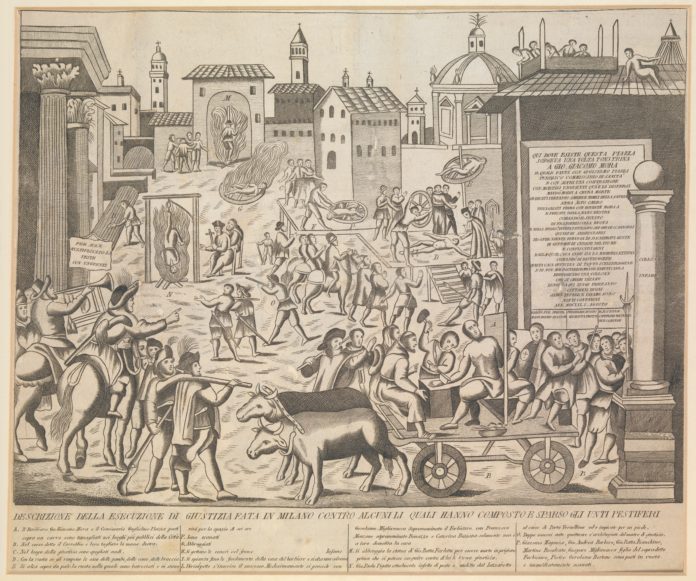
This essay is a part of the COVID-19 dossier, edited by the b2o editorial staff.
by Tony D. Sampson and Jussi Parikka
Up until recently, work on a universal theory of virality seemed to always cut a somewhat marginal figure in media theory. In the early 2000s, when we first started to publish articles referring to digital contagions, immunology, epidemiology and viral networks, it was no surprise to us that although our claim to universality seemed significant, it would remain of ancillary concern to mainstream media theory. After all, media and communication studies were supposed to be about establishing connection; not the opposite of it! We were regularly questioned about our use of a ‘viral metaphor’ and what it meant to the development of a new model of digital media. The hyperbolic focus on viral marketing did not make it any easier for us to argue that there were deeper material levels of virality that required immediate attention.
However, now, all of a sudden, unpredictably, and rather shockingly, viral media stands at the centre of contemporary issues both materially, economically, and socially. In the wake of global uncertainty and anxiety caused by the uncontainable spread of Covid-19, there has been an abrupt move to the viral – from the margin to the middle. As we are all now discovering, Covid-19 is an epochal pandemic. The health and survival of massive scale populations are at stake, engendering panicked political responses and exposing the underlying impact of years of austerity in public policy, not least in healthcare. Virality is, as such, both entirely relevant and resolutely non-metaphorical.
This outbreak has also, understandably, drawn urgent attention to the workings of a viral logics that criss-crosses from biological to cultural, technological and economic contexts. We can now all see how, through sometimes direct experiences, universal virality becomes a techno-social condition of proximity and distance, accident and security, communication and communication breakdown. Indeed, it is in the current context of Covid-19 that our understanding of the movement of people and messages is framed by the logics of quarantine and confinement, security and prevention. Furthermore, virality automates affective reactions and imitative behaviours that relate to different visceral registers of experience compared to those assumed to inform the logic of the market. Which is to say, the mainstream cognitive models that are supposed to support the failing economic model of rational choice (if indeed anyone really ever believed in Homo Economicus) are replaced by seemingly irrational and uncontrollable financial contagion. Moreover, recent outbreaks of panic buying of toilet roll and paracetamol, some of which have been sparked by the global proliferation of Instagram images of empty supermarket shelves, are spreading alongside the early scenes of isolated Italians, impulsively bursting into songs of solidarity and support from their balconies followed up by similar scenes in many other countries and cities. All of these are peculiar contagions because, it would seem, they are interwoven with contagions of psychological fear, anxiety, conspiracy and further financial turmoil; all triggered by the indeterminate spread of Covid-19.
To think these contagions through in a media theory frame is, for a number of reasons, a complex task. We are, after all, dealing with an ecology of technological, biological, and affective realities moving about in strange feedback loops. Contagious agents are not simply biological; their agency always arrives in plurality.
Future predictions are taking place against a backdrop of contested epidemiological models, reliant on, for example, the uncertain thresholds of herd immunity or total social lockdown. Certainly, following a sustained period of comparatively stable risk assessment, mostly based on known knowns and known unknowns, we have just entered a vital, possibly game changing phase in which unknown unknowns will prescribe the near future.
We have to concede that, from the outset, the universality of our viral logics has itself been contested. There have been at least two other models of media virus that we know of. Whether or not it was the first to do seems rather inconsequential now, but Douglas Rushkoff’s Media Virus, published back in 1994, proposed an early viral model that could be harnessed to manipulate the new media. The information-virus, and latter concepts of spreadable media, perceptively challenged the assumed entrenchments of the old ideological state apparatus model of media, pointing toward a novel McLuhanesque participatory culture. We can, perhaps, in retrospect, trace the celebratory nature of this viral logics all the way to the fantasy of revolutionary social media contagions during the Arab Spring.
The second media virus appeared in the early noughties. It was extracted from a few loose remarks made in the latter pages of Richard Dawkins’s neo-Darwinian Selfish Gene thesis of 1976. In Susan Blackmore’s neo-Darwinian Meme Machine, for example, we find a media virus which functions according to an evolutionary algorithm. The neo-Darwinian meme doctrine emerged in various millennial discourses, mostly those associated with the rhetoric of viral marketing and the computer viruses/antivirus arms race. As some viral marketers claimed, contagion may seem accidental, but the pass-on-power of a media message could be memetically encoded (and harnessed) to spread as determined.
The universality of the third media virus – the one we proposed in the early 2000s – was intended to be more theoretically nuanced, certainly in regards to its approach to mechanisms and the question of whom or what does the harnessing. To begin with, our universal virus was more closely aligned to a viral event, or accident of contagion, than it was analogous to, or metaphorically related to, its biological counterpart. We could indeed learn more from the capriciousness of computer viruses than we would by merely looking for analogical relations. As follows, digital contagion provided insights into the modelling of the contagious behaviours of autonomous agents. Similarly, just as computer security became a core focus of digital media practices, the broader implications for virality in network culture also implied the shared legacy with epidemiology and its goal to simulate the spread of diseases. Multi-agent-based modelling was one context where contagions were initially allowed to spread, creating a bifurcated discursive formation between the burgeoning field of artificial life research, on one hand, and the tight link between measures of security and automation, on the other. Along these lines, then, early automated software processes were often grasped as artificial contagions that went beyond the human control of complex computational networks, requiring a further automated immunological response.
Another aim of the universal virus was to reject biological or technological determinism in favour of a transversal contagion. In short, this meant that no one mechanism determined contagion since the relationality and accidentality of the viral event superseded deterministic thinking. Contagious behaviours are not solely predetermined by an evolutionary code, as such. The universal virus also clearly relates to the complex array of unknown unknowns triggered by environmental interactions. Indeed, the vectors of contagion, and any subsequent security response to these environmental conditions, will prove to be effective only after the fact. These are paradoxical environments in which the mode of future predictions, based on existing models and reliant on historical data and assumptions, becomes at odds with the necessary open-ended nature of a shared communication network.
Of course, the story of contagion modelling – either as epidemiological modelling or as conceptualising theoretical models – is not reducible to contemporary network culture. To better grasp the bizarre nature of the kinds of contagious loops we are experiencing with Covid-19, the universal virus also made significant references to nineteenth century contagion theory. Most notably we borrowed from Gabriel Tarde’s society of imitation thesis, which, like Paul Virilio, focused on the accidents of mechanism, rather than a mechanism’s logic. Moreover, Tarde’s imitative social subjects were not the victims, but rather the products of contagion. It is, indeed, in the accidental relations of contagion, that Tarde’s subjects are continuously made and remade.
Like the inexplicable behaviours of crazed shoppers panic buying toilet rolls in recent weeks, the subjectivities that are produced in Tarde’s society of imitation are conspicuously rendered docile sleepwalkers. However, Tarde’s many references to social somnambulism must not be misconstrued as an understanding of society founded entirely on collective stupidity. Importantly, his references to sleepwalking were informed by the absence of a distinction he made between a biological nonconscious inclination and sociocultural tendencies to imitate. In other words, Tarde’s social subjects, including those that were supposed to be making rational economic judgements, are never self-contained. They are both, simultaneously, etched by the affect of others and leaking their own infectious affects. Again, following the logic of the universal virus, recent outbreaks of panic buying and seemingly irrational market trading, are examples of further unpredictable automations of bodies and habits.
Back in early the 2000s, we argued for a universal virus that made a resounding, yet subtle break from established media theory analysis of contagion, doggedly couched in representation. Viruses were not solely metaphorical, figurative or indeed myths that covered up an underlying ideological reality. Following the Covid-19 outbreak, the universal virus can certainly no longer be considered as a conjured-up fantasy, projection, or for that matter, in the current context, a crude biopolitical invention strategically placed to justify measures of containment. Although, for sure, there are multiple levels of political aims at play, not least in terms of the recurring question of immunological borders, the logic of this virus is now, for the time being, the overriding power dynamic. Far from providing a convenient allegory for action, the very real viral event of Covid-19 is currently producing its own reality according to which our habits and worlds must bend and adapt.
Universal viruses are nonrepresentational in the sense that they make their own physical and metaphysical infrastructures of connectivity, while exposing the underlying social strata upon which – as epi–demos – they function. Along these lines, the legal theorist Andreas Philippopoulos-Mihalopoulos contends that Covid-19 presents a Spinozian contagion in terms of how bodies relate to each other and their environment. The “challenge of Covid” is, he argues, “monumentally ethical.” This is because the virus “demands of us to accept a quintessentially Spinozan ethics of positioning, of emplacing one’s body in a geography of awareness of how affects circulate between us and others.”[1] This viral patterning of habit and behaviour is no longer merely a question of homophilic identification (connecting to friends, parents, etc.), but radically expands to modes of connection and disconnection co-determined by collective bodies that are being positioned in relation to each other, to space, to borders, to containment, etc.
The viral patterning of Covid-19 will continue to spur a range of actions, habits, behaviours and affects that might take a hold of bodies in more predictable or previously unimagined ways. Certainly, some of the pegs that fix the future of biopolitical movements of people and messages will no doubt produce more docile sleepwalkers. It is not surprising that the UK government initially opted for a neoliberal version of herd immunity in which collective obligation was pitched alongside business as usual. Even now, in its current state of belated lockdown, the UK’s unequal distribution of Covid testing sees leading political figures and royal family members prioritized over frontline health workers. In the US too, Trump’s reluctance to accept Covid-19’s utter disregard for capitalism seems to be making his country a deadly hub for infection. Indeed, what seems to unify the far-right at this moment is its propensity toward Covid-denial, exemplified by Trump and Bolsonaro’s regime in Brazil. Apparently, sales of guns and ammunition are soaring across the US as fears of Covid-19 prompt bunker mentality and self-protection. It is also the case that the reported spread of the virus has been coupled to an intensification and extension of population racism. In the UK, again, the spread of so-called maskaphobia has led to many Chinese students having to opt between what sociologist Yinxuan Huang calls “two bad choices – insecurity (for coronavirus) and fear (for racism).”[2] Ultimately, urban spaces may well be redefined by state controlled measures of social distancing, on one hand, or these kinds of fear-driven detachments, on the other; both of which clearly contrast with the themes of the classical sociology of cities, which grasped urban spaces as locales of dynamic collective density.
The logic of the universal virus might also produce novel spatiotemporal realities for collective grassroots systems of care. In the wake of Covid-19, we are already witnessing more than the spontaneous emergence of songs of solidarity. Spain is currently nationalizing private hospitals; Iran is releasing political prisoners from jails. These are new spatiotemporal realities produced by Covid-19 that could counter the broader context of what Achille Mbembe has referred to as necropolitics. After the dark refrains of Trump, Brexit and subsequent intensifications of population racism, for example, the horror of Covid-19 might actually clear the way for some kind of large-scale radical reaction that addresses these recent corruptions of the global political scene and its role in quickening climate change and the biodiversity crisis. After the applauding of brave health workers and songs of the shutdown subside, painful social, economic and political struggles will inevitably follow the virus. How these struggles manifest against the shifting backdrop of disciplinary confinement and control by way of statistical inoculation and the abandonment of eradication are yet to be seen.[3] New political assemblages might be triggered, at least temporarily. The question we need to ask now is: what are you doing after the lockdown? We do not mean this to be a catchy social media meme, or indeed a misquotation of Baudrillard, but instead we propose it to be the looming political question we must all face.[4]
The French version of this text is published on AOC. You can find it here.
Tony D Sampson is a critical theorist with an interest in digital media cultures. His publications include The Spam Book, coedited with Jussi Parikka (Hampton Press, 2009), Virality: Contagion Theory in the Age of Networks (University of Minnesota Press, 2012), The Assemblage Brain: Sense Making in Neuroculture (University of Minnesota Press, 2017) and Affect and Social Media: Emotion, Mediation, Anxiety and Contagion, coedited with Darren Ellis and Stephen Maddison (Rowman and Littlefield, 2018). His next book – A Sleepwalker’s Guide to Social Media – will be published by Polity in July 2020. Sampson also hosts the Affect and Social Media international conferences in east London and is co-founder of the community engagement initiative the Cultural Engine Research Group. He works as a reader in digital media cultures and communication at the University of East London.
Jussi Parikka is Professor at University of Southampton (Winchester School of Art) and Visiting Professor at FAMU at the Academy of Performing Arts, Prague where he leads the project on Operational Images and Visual Culture (2019-2023). In 2019-2020, he is also Visiting Chair of Media Archaeology at University of Udine, Italy. His work has touched on questions of virality and computer accidents in the book Digital Contagions: A Media Archaeology of Computer Viruses (2nd. updated edition 2016, Peter Lang Publishing) and he has addressed questions of ecology and media in books such as Insect Media (University of Minnesota Press, 2010) and A Geology of Media (University of Minnesota Press, 2015). The Lab Book, co-authored with Darren Wershler and Lori Emerson, is forthcoming in 2021 (University of Minnesota Press). Parikka’s site is at http://jussiparikka.net.
[1] Andreas Philippopoulos-Mihalopoulos “Covid: The Ethical Disease”. Critical Legal Thinking: Law and the Political, 13 March 2020: https://criticallegalthinking.com/2020/03/13/covid-the-ethical-disease/
[2] Sally Weale “Chinese students flee UK after ‘maskaphobia’ triggered racist attacks: Many say China feels safer than Britain amid coronavirus crisis and increasing abuse”. The Guardian, 17 Mar 2020: https://www.theguardian.com/education/2020/mar/17/chinese-students-flee-uk-after-maskaphobia-triggered-racist-attacks
[3] Philipp Sarasin “Understanding the Coronavirus Pandemic with Foucault?” Foucault Blog, March 31, 2020: https://www.fsw.uzh.ch/foucaultblog/essays/254/understanding-corona-with-foucault?fbclid=IwAR0t0C9bY3D-j-gyjtxj1f6CDz-0kY0KtgnCUhj9LAuOwMc4r7CC0BxAjSc
[4] See also Tuomas Nevanlinna “Poikkeustilan julistaminen on äärimmäistä vallankäyttöä, mutta ratkaiseva hetki koittaa kun se lakkautetaan (Declaring a state of emergency is an extreme exercise of power, but the crucial moment comes when it is lifted)”. Kulttuuricocktail, 26 March 2020: https://yle.fi/aihe/artikkeli/2020/03/28/tuomas-nevanlinna-poikkeustilan-julistaminen-on-aarimmaista-vallankayttoa-mutta



